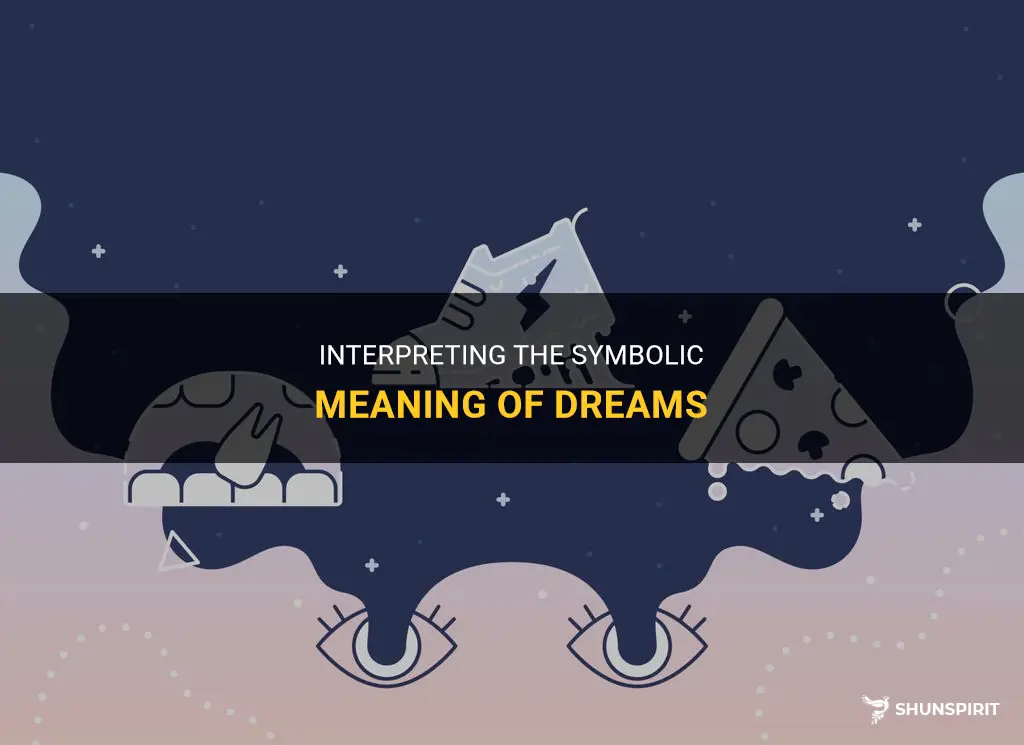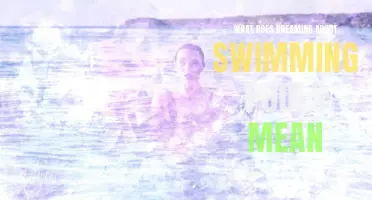
Dreams have long been a source of fascination and intrigue for humans, with countless theories and interpretations attempting to unravel their mysterious nature. One aspect of dreams that has captivated the human mind for centuries is the presence of symbols. These enigmatic images, ranging from everyday objects to mythical creatures, hold a deeper meaning that can provide insights into our subconscious mind. Whether it's a recurring symbol or a fleeting image, understanding the symbolism in dreams can unlock a world of personal growth and self-discovery. In this article, we will delve into the intriguing realm of symbols in dreams and explore their profound significance.
What You'll Learn
- What are some common symbols in dreams and what do they typically represent?
- How can understanding the symbols in our dreams help us better understand ourselves and our emotions?
- Are there cultural or universal symbols that have consistent meanings in dreams across different people?
- Can the same symbol in a dream have different meanings for different individuals?
- Are there any resources or techniques that can help us analyze the symbols in our dreams for a deeper understanding of their meaning?

What are some common symbols in dreams and what do they typically represent?
Dreams have been a topic of fascination and interpretation since ancient times. People have always been curious about the meaning behind their dreams and what they could signify about their subconscious mind. One aspect of dreams that intrigues many individuals is the presence of symbols. Dreams often contain various symbols that have different meanings depending on the context and the dreamer's personal experiences and beliefs. In this article, we will explore some common symbols in dreams and their typical representations.
- Falling: Falling dreams are one of the most common symbols in dreams, and they often occur when we feel out of control or overwhelmed in our waking lives. Falling can represent a fear of failure, a loss of control, or a feeling of instability. It may also symbolize a need for balance and stability in our lives.
- Flying: Flying in dreams is a symbol of freedom, liberation, and the ability to rise above challenges. It indicates a sense of power and control over one's life. Flying dreams often occur during times of personal growth and empowerment.
- Water: Water is a powerful symbol in dreams and can have many different interpretations depending on its form and context. For example, calm and clear water often represents emotional stability and peace of mind. On the other hand, turbulent or murky water may symbolize emotional turmoil or uncertainty. Water can also represent the subconscious mind and the flow of emotions.
- Teeth: Dreams about teeth are commonly associated with anxieties or concerns about one's appearance or self-image. Losing teeth in dreams may represent a fear of losing attractiveness or the ability to communicate effectively. It could also indicate a fear of aging or a loss of vitality.
- Death: Death is a common symbol in dreams, and it rarely represents actual physical death. Instead, it often symbolizes the end of a phase or a significant transition in one's life. Dreaming about death can be a sign of personal transformation, growth, or the need for change.
- Animals: Animals in dreams often represent our instincts, desires, or fears. Each animal has its own symbolism and meaning. For instance, a snake might symbolize transformation or hidden fears, while a lion can represent courage and strength. The interpretation of animal symbols in dreams can vary depending on the dreamer's cultural background and personal associations with specific animals.
It's essential to note that dream interpretation is highly subjective. While some symbols have common interpretations, they can also have individual meanings based on personal experiences and beliefs. It's crucial to consider the feelings, emotions, and experiences associated with a particular symbol in a dream to understand its true meaning for the dreamer.
In conclusion, symbols in dreams can provide valuable insights into the subconscious mind and provide guidance and understanding of our waking lives. Falling, flying, water, teeth, death, and animals are just a few examples of common symbols in dreams and their typical representations. Interpreting dreams and their symbols require a deep understanding of oneself and a willingness to explore the hidden realms of the subconscious mind. By reflecting on these symbols and exploring their personal meanings, individuals can gain valuable insights into their desires, fears, and emotions.
The Enigmatic Interpretation of Incubus Dreams
You may want to see also

How can understanding the symbols in our dreams help us better understand ourselves and our emotions?
Dreams have always fascinated humans and held a certain mystery about them. For centuries, people have tried to interpret and understand the symbols that appear in their dreams in order to gain a deeper understanding of themselves and their emotions. In recent years, researchers have begun to unravel some of the science behind this practice, shedding light on why understanding dream symbols can be an effective tool for self-discovery.
Our dreams are often filled with symbols that represent our thoughts, feelings, and experiences. These symbols can be categorized into universal symbols, personal symbols, and archetypal symbols. Universal symbols are images that have been recognized across cultures and hold similar meanings for people worldwide. For example, a snake often represents transformation and healing, while a rose can symbolize beauty and love.
On the other hand, personal symbols are unique to each individual and carry symbolic meanings that are specific to their personal experiences and memories. For instance, a red door might symbolize home and safety for someone who grew up in a house with a red door. These symbols provide powerful insights into our subconscious mind's interpretation of our experiences and emotions.
Archetypal symbols are another important aspect of dream analysis. Developed by Carl Jung, archetypes are universal patterns or themes that are embedded in the collective unconscious of humanity. Examples of archetypal symbols include the hero, the shadow, and the wise old man. Understanding archetypal symbols in our dreams can shed light on our own journey of self-discovery and personal growth.
By analyzing the symbols in our dreams, we can gain a deeper understanding of ourselves and our emotions. Dreams often reflect our unconscious thoughts and desires that may not be readily available to us in our waking life. For example, if someone dreams about being chased, it could indicate feelings of anxiety or fear that are present in their waking life. By recognizing and understanding this symbol, they can begin to address and work through these emotions.
Dream analysis can also provide insight into the conflicts and challenges we face in our daily lives. Symbols in dreams can represent unresolved issues or internal conflicts that we may not be consciously aware of. For example, a recurring dream of falling may indicate a fear of losing control or feeling overwhelmed. By exploring the symbol of falling further, we can uncover the underlying emotions and fears that contribute to this dream.
Understanding dream symbols can also help us process and heal from past traumas or difficult experiences. Dreams often use symbols to bring these experiences to the surface, allowing us to confront and work through unresolved emotions. For instance, a dream about a broken bridge might symbolize a broken connection or trust in a relationship. By exploring the symbol and its associated emotions, we can begin the healing process and move towards resolution.
To understand the symbols in our dreams, it is essential to keep a dream journal and record our dreams as soon as we wake up. Writing down the symbols, emotions, and any significant events or people in the dream can help us identify patterns and draw connections. It is also helpful to explore the various interpretations of symbols in dream analysis books or consult with a dream analyst or therapist who specializes in this area.
In conclusion, understanding the symbols in our dreams can provide valuable insights into our thoughts, emotions, and experiences. By recognizing the universal, personal, and archetypal symbols that appear in our dreams, we can gain a deeper understanding of ourselves and our emotional landscape. Dream analysis can be a powerful tool for self-discovery and personal growth, allowing us to address unresolved issues, heal from past traumas, and navigate the complexities of our inner world.
The mysterious symbolism behind dreaming of dark shadow figures
You may want to see also

Are there cultural or universal symbols that have consistent meanings in dreams across different people?
Dreams are fascinating phenomena that have intrigued humans for centuries. They provide a glimpse into our unconscious minds and can be a source of insight, creativity, and even messages from our subconscious. One of the most intriguing aspects of dreams is the presence of symbols, which can carry deep meaning and significance. But are these symbols universal, transcending cultural boundaries, or do they have specific meanings within each culture?
Cultural symbols in dreams
Cultural symbols are a reflection of the collective beliefs, norms, and values of a particular culture. These symbols can vary greatly from one culture to another, as they are based on shared experiences, history, and traditions. In dreams, cultural symbols can have a multitude of meanings, depending on the cultural background of the dreamer.
For example, the color red may symbolize luck and prosperity in Chinese culture, while it may be associated with danger and warning in Western cultures. Similarly, the owl is often seen as a symbol of wisdom in Western cultures, but it is considered a bad omen in some Native American cultures. These examples illustrate how cultural symbols can have different interpretations and meanings depending on the cultural context.
Universal symbols in dreams
While cultural symbols can vary greatly, there are certain symbols that seem to appear across different cultures and have consistent meanings. These symbols are often archetypal in nature and tap into the collective unconscious, a concept introduced by psychologist Carl Jung.
Jung believed that certain symbols, such as water, animals, and the mother figure, have universal meanings that transcend cultural boundaries. For example, water is often associated with emotions, purification, and regeneration in dreams, regardless of cultural background. Similarly, animals like snakes and spiders often represent primal instincts, while the mother figure symbolizes nurturance and protection.
Studies have shown that these universal symbols can be found in the dreams of individuals from various cultural backgrounds. In a study conducted by psychologist G. William Domhoff, participants from different cultures reported similar dreams that contained universal symbols such as falling, flying, being chased, or being naked. These findings suggest that there are indeed symbols that are common to all humans and carry consistent meanings in dreams.
However, it is important to note that even these universal symbols may have variations in their interpretation depending on the individual's personal experiences and cultural background. Context is key when analyzing dream symbols, as the personal associations and cultural meanings attached to a symbol can greatly influence its interpretation.
In conclusion, dreams are filled with symbols that can carry deep meaning and significance. While cultural symbols in dreams can vary widely and have specific meanings within each culture, there are also universal symbols that appear across different cultures and carry consistent meanings. These universal symbols tap into the collective unconscious and reflect shared human experiences. However, it is important to take into account the individual's personal experiences and cultural background when interpreting dream symbols.
Unraveling the Depths: Exploring the Meaning Behind Dreams
You may want to see also

Can the same symbol in a dream have different meanings for different individuals?
Dreams have fascinated humans for centuries, and many people believe that they hold deep meanings and messages. Symbols in dreams are particularly intriguing because they often appear without explanation, leaving dreamers to decipher their significance. What makes the interpretation of symbols even more complex is that they can have different meanings for different individuals.
One of the most common symbols in dreams is water. For some, water may represent purification and cleansing, while for others, it may symbolize a sense of calm and tranquility. A scientific study conducted at the University of California, Berkeley found that an individual's cultural background and personal experiences greatly influenced their interpretation of water in dreams. Participants from different cultural backgrounds were shown dream images of water, and their interpretations varied widely. For example, participants from drought-prone regions associated water with abundance and fertility, while those from coastal areas saw it as a symbol of danger and chaos. This highlights how the same symbol can have contrasting meanings depending on one's cultural perspective.
Another example of varying interpretations of a symbol can be seen with the dream symbol of a snake. In many cultures, snakes are associated with danger and deceit. However, in some African cultures, snakes are revered as symbols of wisdom and healing. A person who grew up in a culture that views snakes negatively may interpret a snake dream as a warning or threat, while someone from a culture that reveres snakes may see it as a positive sign or message.
Personal experiences and emotions also play a significant role in the interpretation of symbols in dreams. For instance, a dream about flying may be interpreted as freedom and empowerment by someone who has recently overcome a fear or obstacle in their waking life. On the other hand, someone who is feeling overwhelmed or trapped may interpret a flying dream as a desire to escape or regain control.
Dream analysis experts suggest that understanding the context and emotions surrounding a dream can help unravel its true meaning. They recommend keeping a dream journal, noting down symbols, emotions, and any significant events from the waking life that may be influencing dreams. By examining recurring symbols and themes, individuals can begin to see patterns and gain insights into their dreams.
It is also worth noting that dream symbols can evolve and change over time. What may have once held a particular meaning for an individual may take on a different significance as they grow and experience new things. For example, a dream about a house may have represented stability and security in early adulthood but could later be associated with feelings of confinement or the need for change.
In conclusion, the interpretation of symbols in dreams can vary greatly among individuals. Cultural background, personal experiences, and emotions all contribute to the different meanings attributed to symbols. Understanding the context and emotions surrounding a dream, along with keeping a dream journal, can help individuals decipher the unique symbolism in their dreams. Dreams remain a fascinating and complex phenomenon, and unlocking their hidden meanings continues to be a subject of intrigue for many.
Uncovering the hidden symbolism behind casino dreams
You may want to see also

Are there any resources or techniques that can help us analyze the symbols in our dreams for a deeper understanding of their meaning?
Analyzing the symbols in our dreams can provide us with deeper insights into our thoughts, emotions, and subconscious mind. By understanding the symbolism in our dreams, we can gain a better understanding of ourselves and our lives. There are several resources and techniques that can help us analyze the symbols in our dreams.
Dream journals: Keeping a dream journal is an excellent way to analyze the symbols in our dreams. When we wake up from a dream, immediately writing down the symbols we remember can help us remember more details. By regularly recording our dreams, we can start to notice patterns and recurring symbols, which can provide clues about their meaning.
For example, if we frequently dream about flying, this could indicate a desire for freedom or a sense of empowerment. If we frequently dream about water, it could represent our emotions and the state of our subconscious mind.
Symbolic dictionaries: There are several books and online resources that provide interpretations of dream symbols. These dictionaries can be used as a starting point for understanding the meaning behind the symbols in our dreams. However, it is essential to keep in mind that the interpretation of symbols can vary depending on the individual's personal experiences and cultural background.
For example, dreaming about a snake could be interpreted differently in different cultures. In some cultures, a snake might represent wisdom and transformation, while in others, it might symbolize danger or deceit. Therefore, it is essential to consider our own personal associations with symbols when using symbolic dictionaries.
Active imagination technique: The active imagination technique, developed by Carl Jung, involves engaging in a dialogue with the symbols in our dreams. By imagining ourselves in the dream and interacting with the symbols, we can gain a deeper understanding of their meaning.
For example, if we dream about a lion, we can close our eyes, relax, and visualize ourselves in the dream, having a conversation with the lion. By asking the lion questions and listening to its responses, we can uncover insights and gain a better understanding of what the symbol represents.
Guided imagery: Guided imagery exercises can help us explore the symbols in our dreams in a relaxed and meditative state. By following a guided meditation or visualization exercise, we can enter a dream-like state and explore the symbols with a focused and open mind.
For example, a guided imagery exercise might involve visualizing ourselves in a peaceful forest and encountering various symbols along the way. By paying attention to our thoughts, feelings, and associations with these symbols, we can gain insights into their meaning.
Analyzing the symbols in our dreams is a personal and individual process. What might have a specific meaning for one person may not have the same meaning for another. Therefore, it is essential to approach dream analysis with an open mind and a willingness to explore our own associations and experiences.
By using resources such as dream journals, symbolic dictionaries, active imagination, and guided imagery, we can deepen our understanding of the symbols in our dreams and gain valuable insights into ourselves and our lives. Remember, dream analysis is not an exact science, but rather a tool for self-reflection and personal growth.
Discovering the Symbolic Significance of Bat Dreams
You may want to see also
Frequently asked questions
Dreaming about a snake can symbolize various things depending on the context of the dream. It can represent hidden fears or emotions, transformation or change, or even temptations or deceptive behavior.
Dreaming about flying often symbolizes a sense of freedom, liberation, or empowerment. It may indicate a desire to escape from constraints or limitations in your waking life and embrace new possibilities or perspectives.
Water in dreams can have different meanings depending on its appearance and qualities. It can represent emotions and the unconscious mind, symbolize cleansing or renewal, or indicate a need for emotional healing or purification. Additionally, calm and clear water may signify tranquility and peace, while turbulent or murky water can suggest emotional turmoil or uncertainty.








2 Comments
Sulayman Mata
Yash Mullins